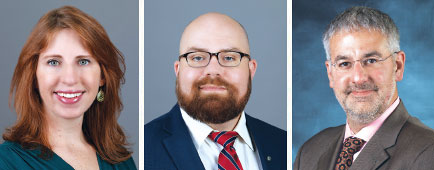Perspectives on Excited Delirium and Ketamine
Abstract
Criteria-based entities like excited delirium are subject to the influences of classism, racism, and a host of systemic biases. This article is one of a series coordinated by APA’s Council on Consultation-Liaison Psychiatry and the Academy of Consultation-Liaison Psychiatry.
In psychiatry over the past 20 years, interest has grown around the dissociative anesthetic ketamine based on the potential of low doses to rapidly improve symptoms of treatment-resistant depression. During the same period, use of ketamine has expanded in both emergency and critical care medicine. In prehospital, emergency department, and intensive care settings, high doses of intramuscular ketamine have become commonplace in the management of “agitation,” which is deemed severe and obstructive to essential medical evaluation and treatment. In an effort to identify patients for whom this severe and/or interfering “agitation” is potentially indicative of an underlying critical illness, the American College of Emergency Physicians (ACEP) coined the term “excited delirium syndrome” in a 2009 white paper.
Problematically, excited delirium is a fusion of both a qualitative descriptor (“excited”) and a pre-existing diagnosis in the realm of psychiatry (“delirium”). However, the criteria for excited delirium syndrome (see box), also sometimes called “agitated delirium,” do not align with any DSM conception of the syndrome of delirium. Additionally, because the term “agitation” is used commonly and imprecisely across a variety of medical settings and beyond, clarity about the nature and utility of excited delirium syndrome is elusive.
Prehospital Potential Features of Excited Delirium Syndrome
Pain tolerance
Tachypnea
Sweating
Agitation
Tactile hyperthermia
Police noncompliance
Lack of tiring
Unusual strength
Inappropriately clothed
Mirror/glass attraction
Source: “White Paper Report on Excited Delirium Syndrome,” American College of Emergency Physicians, September 10, 2009.
Clinical presentations involving “agitation” led frontline medical personnel to recognize that patients with the most severe intoxication syndromes involving stimulants had some features in common. Because their behavior and the circumstances in which it was encountered precluded having medically relevant information (apart from what could be observed at a distance), patients were categorized as having excited delirium syndrome as a way to describe the problem. Adopting that nosology quickly led to practice pathways involving the conceptualization of such individuals with the features listed in the box as patients with potentially life-threatening intoxications.
What is not known, however, is how often patients with those presenting characteristics actually have the dangerous metabolic derangements and impending cardiovascular collapse described by the ACEP task force. A 2017 review of excited delirium acknowledged limitations of the construct and the clinical research underlying it, according to Philippe Gonin and colleagues in the May 2018 Academic Emergency Medicine. The review pointed out that excited delirium syndrome criteria are highly subjective and inconsistently applied in practice. Further complicating matters is the reality that physicians are rarely the professionals directly assessing the features of most patients who may meet criteria for this syndrome. Rather, patients get to emergency departments based on the impressions of first responders. With subjective criteria and the complex factors that bias observation and human decision-making, many patients who do not have a dangerous medical condition may be treated “aggressively” as though they do.
As we have learned in psychiatry with examples like the overdiagnosis of people of color with schizophrenia compared with the related condition of bipolar disorder, criteria-based entities like excited delirium are subject to the influences of classism, racism, and a host of systemic biases. In the first large study reviewing psychiatric outcomes after prehospital use of ketamine for “severe agitation,” the only patient characteristic that predicted treatment with that agent over benzodiazepines was being Black, according to Jacob A. Lebin, M.D., and colleagues in the August 2019 Academic Emergency Medicine. For these reasons, and citing that the use of the term excited delirium may justify “law enforcement use of excessive force,” the AMA “oppose[s] the use of excited delirium as a medical diagnosis.” APA also opposes the term; the Board of Trustees approved a position statement in December 2020 drafted by the Council on Psychiatry and the Law that says “The term ‘excited delirium’ is too nonspecific to meaningfully describe and convey information about a person.”
As currently conceived, excited delirium is not a valid clinical diagnosis, but a loosely defined syndrome without a verifiable pathophysiology. The label points to a problem at the interface of medicine, law, and society, which encapsulates a differential diagnosis of etiologies that do not all have the same treatments. Those validated conditions do need to be identified and managed properly for each “excited delirum–appearing” patient with a challenging set of circumstances as the starting point for care.
Psychiatrists, particularly those working as consultants in emergency and general medical settings, have an opportunity to be helpful in this arena. Recognizing the high intensity and acuity of the situations in question and not reacting merely with judgment of our colleagues is an essential start. We can make ourselves available to assist with reforms, particularly by educating other disciplines about the many conditions that manifest abnormal behavior with accompanying methods to respond in a more nuanced, empathic, and therapeutic fashion. Such collaboration opens up opportunities to remind specialists in emergency and critical care that, for all the advantages offered by ketamine, the psychiatric consequences of having a drug administered involuntarily that causes profound dissociation may be severe—especially for those with a pre-existing history of trauma.
Embedding psychiatrists, psychologists, social workers, and others with mental health expertise into teams (police and emergency medical services) and locations (the streets and emergency departments) where patients first present with behavioral unrest may decrease this use of ketamine in favor of dialogue and partnership that both protect the public and get patients the care they need. ■
The authors would like to acknowledge Courtney S. Rasimas, B.A., M.P.H., for her assistance in review and editing of this article.




